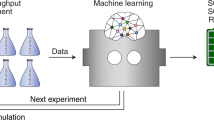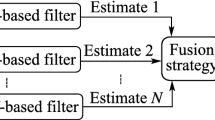Abstract
This chapter presents a data-based approach to nonlinear observer design for battery state of charge (SoC) estimation. The SoC observer is based on a purely data-driven model in order to allow for the application of the proposed concepts to any type of battery chemistry, especially when conventional physical modelling is not easily possible. In order to cope with the complex nonlinear dynamics of the battery, an integrated workflow for experiment design, model creation and automated observer design is proposed. The nonlinear battery model is constructed using a proven training algorithm based on the architecture of local model networks (LMNs). One important advantage of LMNs is that they offer local interpretability, which enables the extraction of local linear battery impedance models for automated nonlinear observer design. The proposed concepts are validated experimentally using real measurement data from a lithium-ion power cell.
Access this chapter
Tax calculation will be finalised at checkout
Purchases are for personal use only
Similar content being viewed by others
References
Arora P, Doyle M, Gozdz AS, White RE, Newman J (2000) Comparison between computer simulations and experimental data for high-rate discharges of plastic lithium-ion batteries. J Power Sources 88(2):219–231. doi:10.1016/S0378-7753(99)00527-3
Bhangu B, Bentley P, Stone D, Bingham C (2005) Nonlinear observers for predicting state-of-charge and state-of-health of lead-acid batteries for hybrid-electric vehicles. IEEE Trans Veh Technol 54(3):783–794. doi:10.1109/TVT.2004.842461
Bishop CM (1995) Neural networks for pattern recognition. Oxford University Press, USA
Brown M, Lightbody G, Irwin G (1997) Local model networks for nonlinear system identification. In: IEE colloquium on industrial applications of intelligent control (Digest No: 1997/144), pp 4/1–4/3. doi:10.1049/ic:19970785
Chen G, Xie Q, Shieh LS (1998) Fuzzy kalman filtering. Inf Sci 109(14):197–209. doi:10.1016/S0020-0255(98)10002-6
Gomadam PM, Weidner JW, Dougal RA, White RE (2002) Mathematical modeling of lithium-ion and nickel battery systems. J Power Sources 110(2):267–284. doi:10.1016/S0378-7753(02)00190-8
Goodwin G, Payne R (1977) Dynamic system identification: experiment design and data analysis. In: Mathematics in science and engineering, vol 136. Academic Press, New York
Gregorcic G, Lightbody G (2007) Local model network identification with gaussian processes. IEEE Trans Neural Netw 18(5):1404–1423. doi:10.1109/TNN.2007.895825
Hametner C, Jakubek S (2007) Neuro-fuzzy modelling using a logistic discriminant tree. In: American control conference, 2007 ACC ’07, pp 864–869. doi:10.1109/ACC.2007.4283048
Hametner C, Jakubek S (2013) Local model network identification for online engine modelling. Inf Sci 220(0):210–225, doi:10.1016/j.ins.2011.12.034, http://www.sciencedirect.com/science/article/pii/S0020025512000138, online Fuzzy machine learning and data mining
Hametner C, Jakubek S (2013) State of charge estimation for lithium ion cells: design of experiments, nonlinear identification and fuzzy observer design. J Power Sources 238(0):413–421. doi:10.1016/j.jpowsour.2013.04.040
Hametner C, Nebel M (2012) Operating regime based dynamic engine modelling. Control Eng Pract 20(4):397–407. doi:10.1016/j.conengprac.2011.10.003, http://www.sciencedirect.com/science/article/pii/S0967066111002085
Hametner C, Mayr CH, Kozek M, Jakubek S (2013) PID controller design for nonlinear systems represented by discrete-time local model networks. Int J Control 86(9):1453–1466. doi:10.1080/00207179.2012.759663, http://www.tandfonline.com/doi/abs/10.1080/00207179.2012.759663, http://www.tandfonline.com/doi/pdf/10.1080/00207179.2012.759663
Hametner C, Stadlbauer M, Deregnaucourt M, Jakubek S, Winsel T (2013) Optimal experiment design based on local model networks and multilayer perceptron networks. Eng Appl Artif Intell 26(1):251–261. doi:10.1016/j.engappai.2012.05.016, http://www.sciencedirect.com/science/article/pii/S0952197612001224
Han J, Kim D, Sunwoo M (2009) State-of-charge estimation of lead-acid batteries using an adaptive extended kalman filter. J Power Sources 188(2):606–612. doi:10.1016/j.jpowsour.2008.11.143
Hu Y, Yurkovich BJ, Yurkovich S, Guezennec Y (2009) Electro-thermal battery modeling and identification for automotive applications. In: ASME conference proceedings 2009(48937), pp 233–240. doi:10.1115/DSCC2009-2610
Johansen TA, Foss BA (1995) Identification of non-linear system structure and parameters using regime decomposition. Automatica 31(2):321–326. doi:10.1016/0005-1098(94)00096-2
Klein R, Chaturvedi N, Christensen J, Ahmed J, Findeisen R, Kojic A (2010) State estimation of a reduced electrochemical model of a lithium-ion battery. In: American control conference (ACC), 2010, pp 6618–6623
Ljung L (2008) Perspectives on system identification. In: Proceedings of the 17th IFAC world congress
Mayr C, Hametner C, Kozek M, Jakubek S (2011) Piecewise quadratic stability analysis for local model networks. In: 2011 IEEE international conference on control applications (CCA), pp 1418–1424. doi:10.1109/CCA.2011.6044503
Morris M (1995) Exploratory designs for computational experiments. J Stat Plan Infer 43(3):381–402. doi:10.1016/0378-3758(94)00035-T
Murray-Smith R, Johansen TA (1997) Multiple model approaches to modelling and control. Taylor & Francis, London
Nelles O (2002) Nonlinear system identification, 1st edn. Springer, Berlin
Polansky M, Ardil C (2007) Robust fuzzy observer design for nonlinear systems. Int J Math Comput Sci 3:1
Pronzato L (2008) Optimal experimental design and some related control problems. Automatica 44(2):303–325
Pucar P, Millnert M (1995) Smooth hinging hyperplanes—an alternative to neural networks. In: Proceedings of the 3rd ECC
Senthil R, Janarthanan K, Prakash J (2006) Nonlinear state estimation using fuzzy kalman filter. Ind Eng Chem Res 45(25):8678–8688. doi:10.1021/ie0601753
Simon D (2003) Kalman filtering for fuzzy discrete time dynamic systems. Appl Soft Comput 3(3):191–207. doi:10.1016/S1568-4946(03)00034-6
Sjoberg J, Zhang Q, Ljung L, Benveniste A, Deylon B (1995) Nonlinear black-box modeling in system identification: a unified overview. Automatica 31:1691–1724
Tanaka K, Ikeda T, Wang H (1998) Fuzzy regulators and fuzzy observers: relaxed stability conditions and LMI-based designs. IEEE Trans Fuzzy Syst 6(2):250–265. doi:10.1109/91.669023
Vasebi A, Partovibakhsh M, Bathaee SMT (2007) A novel combined battery model for state-of-charge estimation in lead-acid batteries based on extended kalman filter for hybrid electric vehicle applications. J Power Sources hybrid Electr Veh 174(1):30–40. doi:10.1016/j.jpowsour.2007.04.011
Vasebi A, Bathaee S, Partovibakhsh M (2008) Predicting state of charge of lead-acid batteries for hybrid electric vehicles by extended kalman filter. Energy Convers Manage 49(1):75–82, doi:10.1016/j.enconman.2007.05.017
Acknowledgments
This work was supported by the Christian Doppler Research Association and AVL List GmbH, Graz.
Author information
Authors and Affiliations
Corresponding author
Editor information
Editors and Affiliations
Rights and permissions
Copyright information
© 2014 The Author(s)
About this chapter
Cite this chapter
Hametner, C., Jakubek, S. (2014). Data-Driven Methodologies for Battery State-of-Charge Observer Design. In: Thaler, A., Watzenig, D. (eds) Automotive Battery Technology. SpringerBriefs in Applied Sciences and Technology(). Springer, Cham. https://doi.org/10.1007/978-3-319-02523-0_7
Download citation
DOI: https://doi.org/10.1007/978-3-319-02523-0_7
Published:
Publisher Name: Springer, Cham
Print ISBN: 978-3-319-02522-3
Online ISBN: 978-3-319-02523-0
eBook Packages: EngineeringEngineering (R0)




